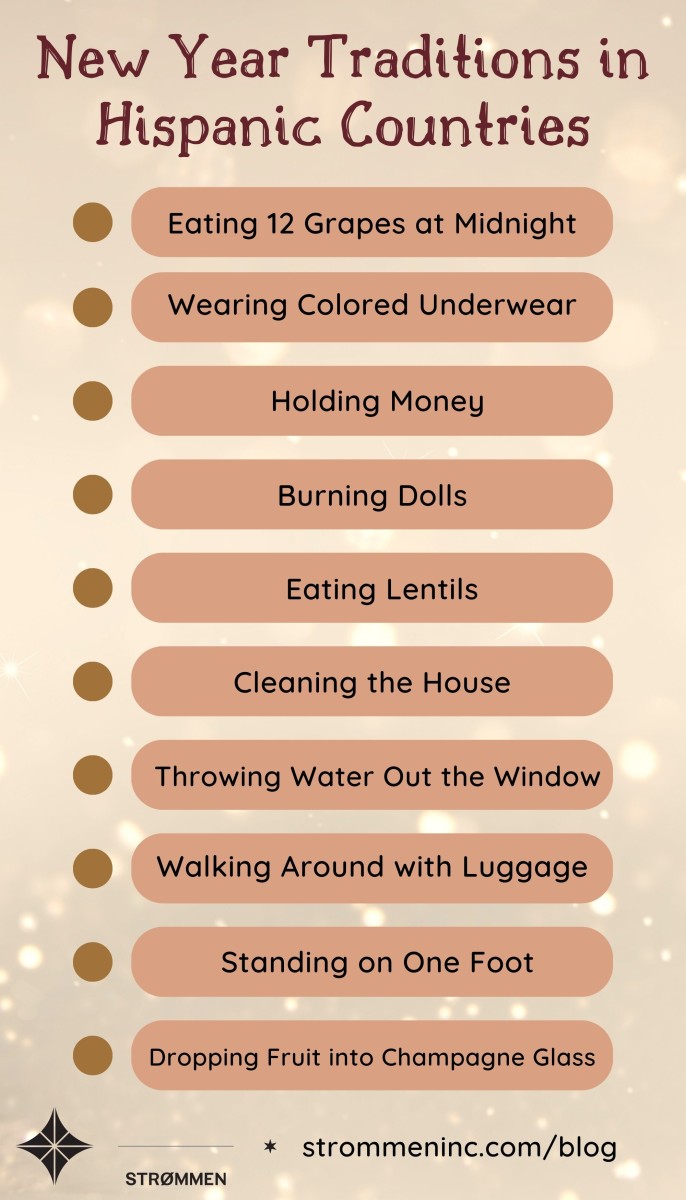New Year Traditions bring a unique tapestry of customs, colors, and celebrations across Hispanic countries. As the clock strikes midnight, the world welcomes a new chapter, and in the heart of these vibrant cultures, the echoes of age-old traditions resound.
Join us as we embark on a journey to explore the rich tapestry of New Year festivities in Hispanic countries, where each tradition is a symbol of hope, prosperity, and the shared joy of new beginnings.
Also For You: Unwrapping The Magic: A Guide To Spanish Christmas Vocabulary
10 New Year Traditions in Hispanic Countries
1. Eating 12 Grapes at Midnight
Originating in Spain, the tradition of eating 12 grapes at the stroke of midnight is deeply ingrained in New Year celebrations. Each grape represents a wish for the upcoming months, and as the clock chimes twelve times, individuals across Spain and other Spanish-speaking nations hastily consume the twelve grapes, hoping for good luck and prosperity throughout the year. This tradition has become a festive and lighthearted way to welcome the New Year.
2. Wearing Colored Underwear
In countries like Mexico and Brazil, the choice of underwear color on New Year’s Eve is not just a matter of personal preference; it carries deep symbolic significance. Red underwear is associated with love and passion, yellow with wealth and prosperity, and white with peace and harmony. This tradition adds a playful and colorful dimension to the New Year’s wardrobe, as individuals carefully select their undergarments based on their aspirations for the year ahead.
3. Holding Money
As the clock approaches midnight in Ecuador and various Latin American countries, a unique tradition unfolds – holding money in hand or pocket. The belief is that by doing so, individuals are ensuring financial abundance and prosperity in the coming year. This ritual is a tangible expression of the hope for economic well-being, as people enter the New Year with a symbolic gesture of wealth in their grasp.
4. Burning Dolls
In Panama and Colombia, the New Year is ushered in by the ritual of burning “Año Viejo” dolls. These dolls, crafted to represent the old year, are set ablaze at midnight. The act symbolizes the casting away of negativity and challenges from the past year, making room for positive changes and a fresh start. It’s a visually striking and cathartic tradition that encapsulates the spirit of renewal.
5. Eating Lentils
New Year’s Eve in Brazil and Venezuela is often marked by the consumption of lentils. The round shape of lentils is reminiscent of coins, symbolizing wealth and prosperity. By including lentils in their New Year’s meal, people express the desire for financial success and abundance in the months to come. This culinary tradition beautifully blends cultural beliefs with a delicious start to the year.
6. Cleaning the House
As the countdown to midnight begins in many Hispanic cultures, so does the tradition of thorough house cleaning. This act is more than a practical preparation for the festivities; it is a symbolic gesture of clearing away the old and making space for the positive energy of the New Year. A spotless home is seen as an open canvas, ready to be filled with the blessings and opportunities of the coming year.
7. Throwing Water Out the Window
In some regions of Puerto Rico, the New Year is welcomed by the unconventional practice of throwing a bucket of water out of the window. This symbolic act is believed to cleanse the living space of negative energy, creating a fresh and positive environment for the beginning of the year. It’s a unique tradition that adds an element of surprise to the celebrations.
8. Walking Around with Luggage
In Mexico, a peculiar yet widely observed tradition involves taking a short stroll around the block with an empty suitcase on New Year’s Eve. This act is believed to invite travel and adventure in the coming year. Whether it’s a symbolic gesture or a lighthearted belief, the act of walking with luggage reflects a collective hope for exciting journeys and new experiences in the upcoming months.
9. Standing on One Foot
In Argentina, the stroke of midnight brings a quirky tradition – standing on one foot. This act, while seemingly whimsical, is believed to bring stability and balance to one’s life in the coming year. It’s a lighthearted way to embrace the New Year with a sense of poise and equilibrium.
10. Dropping Fruit into Champagne Glass
In some Latin American countries, a distinctive New Year’s Eve tradition involves dropping a coin, ring, or piece of fruit into a champagne glass as the clock strikes twelve. This act symbolizes the desire for good fortune and prosperity in the coming year. The clinking of the objects in the glass is a joyful and hopeful sound that resonates with the optimism of a fresh start.
New Year Vocabulary in Spanish
Now, let’s delve into the linguistic landscape of New Year celebrations with a selection of festive vocabulary in Spanish and English.
| English | Spanish |
| New Year | Año Nuevo |
| New Year’s Eve | Nochevieja |
| Celebration | Celebración |
| Party | Fiesta |
| Toast | Brindis |
| Wishes | Deseos |
| Resolution | Resolución |
| Fireworks | Fuegos Artificiales |
| Clock | Reloj |
| Hug | Abrazo |
¡Feliz Año Nuevo! (Happy New Year!)
In the kaleidoscope of New Year traditions and vibrant vocabulary across Hispanic countries, a common thread emerges – the spirit of unity, hope, and shared celebration. From the whimsical act of eating twelve grapes in Spain to the heartfelt embrace of loved ones at midnight, each tradition weaves a unique narrative, reflecting the rich tapestry of cultural diversity.
As we embrace the cultural intricacies and linguistic nuances, let us revel in the unity that transcends borders. The New Year serves as a universal reminder that, despite our diverse traditions and languages, we share a common desire for joy, prosperity, and a brighter future.
¡Feliz Año Nuevo y prospero año nuevo! (Happy New Year and prosperous New Year!)Want to learn more Spanish? Our expert staff will get in touch within 24 hours, and you can start practicing your Spanish right away. Sign up for a group class (online or in person) or test your level for free with our free quizzes.





